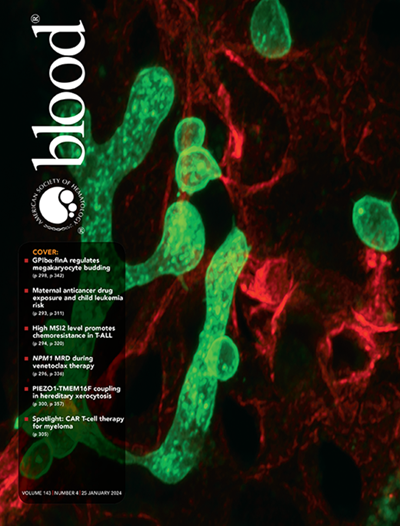组织转谷氨酰胺酶驱动纤维蛋白β链交联:在创伤患者中观察到的一种新的纤维蛋白修饰。
IF 23.1
1区 医学
Q1 HEMATOLOGY
引用次数: 0
摘要
血浆转谷氨酰胺酶凝血因子XIII (FXIII)与纤维蛋白的共价交联是血凝块稳定性和功能的关键决定因素。fxiii催化的ε-N-(γ-谷氨酰)-赖氨酸交联的形成仅限于纤维蛋白γ-链和α-链,并遵循凝血酶驱动的纤维蛋白聚合。纤维蛋白原也通过组织转谷氨酰胺酶(TG2)在有利于分子内和分子间a-g交联的反应中交联。新出现的证据表明,纤维蛋白原是急性组织损伤条件下TG2的相关底物。值得注意的是,除了检测到典型的fxiii定向交联(即a-a, g-g)外,我们还发现了涉及纤维蛋白原β链的全新共价交联(即b-a,通过FGB-Q82)。在体外凝血反应中加入TG2,并在还原条件下分析纤维蛋白(原),发现β链多肽的丢失伴随着高分子量β链物种的形成。基于质谱的体外血块交联蛋白质组学分析再现了在创伤患者血浆制成的血块中观察到的tg2定向β链交联。该结果首次记录了纤维蛋白β链的体外和离体交联,并突出了TG2作为相关血浆转谷氨酰胺酶的新例子。本文章由计算机程序翻译,如有差异,请以英文原文为准。
Tissue transglutaminase drives fibrin β-chain cross-linking: a novel fibrin modification observed in trauma patients.
Covalent crosslinking of fibrin by the plasma transglutaminase coagulation factor XIII (FXIII) is a key determinant of blood clot stability and function. FXIII-catalyzed formation of ε-N-(γ-glutamyl)-lysyl crosslinks is restricted to the fibrin γ- and α-chains and follows thrombin driven fibrin polymerization. Fibrinogen is also crosslinked by tissue transglutaminase (TG2) in a reaction favoring intra- and intermolecular a-g crosslinking. Emerging evidence points to fibrinogen as a relevant substrate of TG2 in conditions of acute tissue damage. Remarkably, beyond detection of prototypical FXIII-directed crosslinks (i.e., a-a, g-g), we identified entirely novel covalent crosslinks involving the fibrinogen β chain (i.e., b-a, via FGB-Q82). Addition of TG2 to in vitro clotting reactions and analysis of fibrin(ogen) in reducing conditions revealed loss of β chain polypeptide paired with formation of high-molecular weight β chain species. Mass spectrometry-based crosslinking proteomic analysis of in vitro clots recapitulated the precise TG2-directed β chain crosslinks observed in clots made using the plasma of trauma patients. The results are the first to document in vitro and ex vivo crosslinking of the fibrin β chain and highlight a novel example of TG2 emerging as a relevant plasma transglutaminase.
求助全文
通过发布文献求助,成功后即可免费获取论文全文。
去求助
来源期刊

Blood
医学-血液学
CiteScore
23.60
自引率
3.90%
发文量
955
审稿时长
1 months
期刊介绍:
Blood, the official journal of the American Society of Hematology, published online and in print, provides an international forum for the publication of original articles describing basic laboratory, translational, and clinical investigations in hematology. Primary research articles will be published under the following scientific categories: Clinical Trials and Observations; Gene Therapy; Hematopoiesis and Stem Cells; Immunobiology and Immunotherapy scope; Myeloid Neoplasia; Lymphoid Neoplasia; Phagocytes, Granulocytes and Myelopoiesis; Platelets and Thrombopoiesis; Red Cells, Iron and Erythropoiesis; Thrombosis and Hemostasis; Transfusion Medicine; Transplantation; and Vascular Biology. Papers can be listed under more than one category as appropriate.
 求助内容:
求助内容: 应助结果提醒方式:
应助结果提醒方式:


